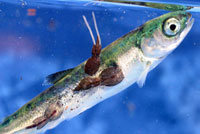Sea lice kill wild salmon in Canada
Parasites, particularly lice, engender the population of wild salmon on the west coast of Canada. Wild pink salmon around the Broughton Archipelago may die out during the period of ten years just because of parasites coming from nearby fish farms, a study says.

Sea lice are natural parasites that usually attach to adult salmon with little ill effect and have little contact with vulnerable juvenile salmon. The situation changes when the fish farms move in, according to a study to be published Friday in the journal Science.
In natural conditions, the adult salmon that carry the sea lice aren't in the migration channels and rivers at the same time as young pink and chum salmon, so the little fish are rarely exposed.
When fish farms move in, hundreds of thousands of adults are raised in floating net pens anchored year-round in the channels where the young wild fish migrate. The study suggested that the density of fish farms reached a tipping point in 2001 that triggered a killer sea lice infestation.
When West Coast salmon catches in the United States crashed in the 1990s, farmed salmon filled the gap in supermarket coolers. Global production has been growing ever since.
The study found that sea lice infestations around salmon farms in British Columbia's Broughton Archipelago, north of Vancouver Island, have reached a density so high they are killing juvenile wild pink salmon at a rate fast enough to drive local runs to extinction within another four years.
"This is the first time scientists have had enough detailed data to actually measure the impact of sea lice on wild salmon populations," said Martin Krkosek, lead author of the study and a doctoral candidate at the Center for Mathematical Biology at the University of Alberta.
The Canadian Department of Fisheries and Oceans, which regulates salmon farms and is responsible for protecting wild salmon, said the study overstates the risks, which are not consistent with figures for pink salmon returns since 2002, when populations collapsed.
"They are asking us to believe 80 percent mortality is from one source," said Brian Riddell, head of the salmon science branch of the department's Pacific Biological Station in Nanaimo, B.C. "That's simply unrealistic."
The authors suggested that the simple solution is to move fish farms out of salmon migration corridors, but Riddell said that was impractical given the prevalence of wild salmon.
Alexandra Morton, a co-author and director of the Salmon Coast Field Station in the archipelago, said wild salmon are surviving commercial fishing but not sea lice.
"The trajectory is much steeper than we expected," she said.
Ray Hilborn, a professor of fisheries at the University of Washington who was not associated with the study, said he replicated the analysis and agreed with the conclusions. But the stream surveys are far from exact, he said.
"It is a very localized effect," not likely to threaten pink salmon populations in general, he said.
Wild pink salmon are not a commercially important species, but they are an important food source for orcas and other salmon in the ocean. They also provide food for bears and other wildlife and nutrients for trees.
Subscribe to Pravda.Ru Telegram channel, Facebook, RSS!





